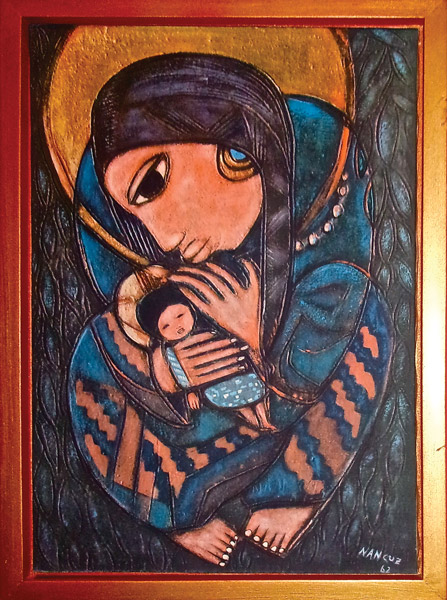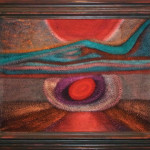Nan Cuz – Artist Profile Guatemala
Nan Cuz – A Journey to the Uncharted Depths of a Soul
A tribute exhibition honoring the work of Nan Cuz “Magic and Emotions” will be open through June 16.
She sits alone now, in her garden, watching the birds come and go, listening to the gentle clacking of the giant bamboo, this tiny little woman. She looks up as I approach and smiles, and I disappear into her eyes, those eyes that have seen miraculous worlds for 90 years and shared them with us.
Nan Cuz was born Jan. 4, 1927 in Secoyocte, Municipio de Senahú, in Alta Verapaz, Guatemala of a Q’eqchi Maya mother, Filomena Cuz, and a German father, Hermann Heinemann. She lived with her mother and grandmother in the traditional way, as her father had returned to Germany.
In 1934 Heinemann’s German wife, who was unable to have children, traveled to Guatemala to bring Nan back to Germany in order to provide her with a good education. Nan was 7 years old.
Although the agreement was that Nan would be returned to her mother when she completed her schooling, World War II and its aftermath prevented this, and Nan was not to see her mother again for 32 years. Is it any wonder that this traumatic event is depicted multiple times in her so-called Madonna and Child paintings?
The Madonna is not the Christian Madonna, however, but a cross-cultural Madonna, a Great Mother image, a Mother Earth, displaying a poignancy that brings tears to the eye of the beholder, whether or not one is aware of Nan’s history.
Imagine a 7-year-old child who spoke only Q’eqchi Mayan and had never worn shoes arriving in Germany in the era of Nazi power. But Nan brought her own power and a striking intelligence, which enabled her to gradually earn the respect of her peers, although they taunted her for her small size and brown skin, calling her ”little monkey.”
Nan was 18 when the war ended. Her father was a professional photographer and taught Nan the craft, but she soon moved on to painting. In 1950 she met and married George Schaefer.
They lived in a community on the way to Hamburg and people from all corners of the world passed through, including many artists, writers and philosophers, introducing her to the cultures of the world, which she absorbed and transmuted into her own unique perspective.
Nan was beginning to receive artistic recognition in Europe. The scenes and colors of her native land were deeply imbedded in her psyche and appeared to her in dreams and visions, which she expressed in her art.
Her work presents us with many aspects of the everyday life of the Maya people, but also gives a strong sense of their spiritual life as well. Above all is the deep and eternal connection with the Earth, nature and all living beings.
The second theme that runs through most of Nan’s work is that of Paradise Lost, or rather rediscovered, which comes from deep within the unconscious and indeed taps into the Jungian Universal Unconscious Archetypes, where myth, spiritualism and dream imagery combine to produce visions of a miraculous world that may someday be regained.
Landscapes, colors, people, animals and plants buried deep in that 7-year-old psyche emerge seemingly without effort as the past and present merge into a possible future when love of nature and humanity surfaces once again.
While the majority of the imagery resonates from the Mayan culture, others arise from Buddhist, Egyptian, Peruvian and other indigenous roots. This can be seen from a German newspaper photo from 1960, titled: The Return of Quetzalcoatl. Unfortunately the painting is lost.
In 1968 Guatemalan First Lady Sara de Méndez Montenegro invited Nan to visit and she was reunited with her mother and extensive Guatemalan family. The exhibition of her work was a huge success and in 1971 she returned to Guatemala with Schaefer and her two children, Thomas and Maya, settling in permanently in Panajachel.
Here they created the Galeria de Nan Cuz, one of the first art galleries in Guatemala, which soon became the social, intellectual and artistic center of the town and is a work of art in its own right. In the late ‘70s Nan and Schaefer separated and eventually divorced.
She married Horst Koehler in 1987, who shared her deep interest in Tibetan Buddhism, and they traveled the world together until his death in 1995. During this period her work expressed more of the transformational dimension, moving from the magical to the mystical.
Although the influence of Klee and Chagall are apparent, Nan soon found her own niche in what one critic called “sophisticated naivety.” Her work speaks to the child in all of us, but contains as well a deeply personal naturalistic mysticism.
Figures float among the clouds, the stars, part human, part something else— animal, vegetable, mineral. Their eyes stare out at us, their knowing eyes, Nan’s eyes. They offer us glimpses into another world, magical and beautiful.
Nan Cuz is truly a Guatemalan National Treasure.
REVUE article by Dorothy Kethler
Magic and Emotions by Nan Cuz
in a tribute exhibition honoring her work,
open through June 16
(Tues.-Fri., 10am-5pm; Sat., 10am-1pm).
ArteCentro Graciela Andrade de Paiz (1st level),
9-A calle 8-54, z. 1, Guatemala City
- Asi Cantaba la Flaute, 1987
- La Cruz Maya, circa 1987
- Esperanza, circa 1972
- Transformation#4, 1983-85










What an excellent magazine – I even like the posts!
Thank you very much!
Great article!!!
Wow good article Dorothy on Nan.s beautiful art—nice story and thanks for posting
Great artist! Love his work!
Beautiful and touching… Thank you for sharing!
Thank you for this article. I remember going to her studio (near Lake Atitlan, as I recall) and buying two prints which we still have and value 45 years later. I’m afraid that we haven’t done a good job of framing but Vendedora de Flores and Madrecitas have been hanging in our houses (through ten moves or more) since then.
Excellent review with many insights into the creative and artist genius of Nan Cuz. I’ve used it to research a book she illustrated, “In The Kingdom of Mescal: An Indian fairy-tale for adults” and I’m still digging…
Excellent review with many insights into the creative and artistic genius of Nan Cuz. I’ve used the article to research a book she illustrated, “In the Kingdom of Mescal: An Indian fairy-tale for adults” and I’m still digging. The book was gift to my parents by some Guatemala/German friends who visited them in Colorado.
Also–can you connect me with the author Dorothy Kethler as I’m working on an essay on the making of Nan Cuz’s book, “In the Kingdom of Mescal: An Indian Fairy-tale for Adults” which could lead to an article Revue might consider.
I have inherited a piece of art that seems to say Madrecitas. It’s subject is 5 green females. Is this a work done by Nan Cuz? Does anyone have any idea of the approximate value? Thank-you.
I have the painting Nan Cuz – A Journey to the Uncharted Depths of a Soul. Is there any interest in buying it? Please contact me at mikael.haverdal@gmail.com.
Kind regards
Mikael
Thank you for the background information on Nan Cuz.
We have a signed Nan Cuz lithograph titled “flauta de los Andes” purchased in Guatemala around 1988. Would anyone have a clue as to it’s value?
Rose, I think your best bet would be to contact Nan’s son at their Gallery on Lake Atitlan in Guatemala–here’s there website.
If you want to know more about the artist my article was published in last month’s issue–“The Making of the Kingdom of Mescal: An Indian Adult Fairy-Tale.” starting on page 12. https://issuu.com/revue/docs/revue_magazine_may_2018?utm_source=2018W18_subscribers&utm_campaign=Digest&utm_medium=email
Good Luck,
Mark
I knew the family well and bought what i think is her best piece. 1973 or 1974. The corn God. I would like to collect more.of her paintings. Timsurf04@yahoo.com
I love Nan Cuz’s painting of the horses with the people titled “Despedida de un Moribundo, 1958” (“Farewell to a Dying Man, 1958”). It’s one of my most favorite of all of her works, although I have many of her beautifully framed prints already. I used to love to play the piano for Nan as well, when she would come and sit near me while I played the lovely antique grand piano at La Galeria. Being with Nan at La Galeria were some of the best days of my life in Panajachel at Lake Atitlan, and a big reason why I have stayed here ever since.
Sabine and Thomas (Nan’s son) are still here and even though Tomas’s health isn’t the best they still keep La Galeria open at certain times. They are still the cultural and artistic center of Panajachel and we are all so grateful for this.
CatherineTodd2 (at) gmail (dot) com